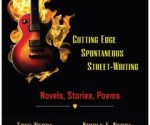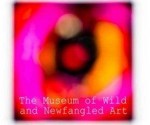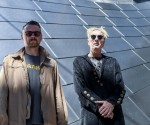We Talk with Laura Israel, director of the film Don’t Blink – Robert Frank
 As a film director and editor, Laura Israel has covered some diverse topics beginning with music videos and experimental works to the politics of wind energy in her first feature Windfall to the life of photographer and filmmaker Robert Frank in her newest documentary Don’t Blink – Robert Frank. She had a unique opportunity to capture the true essence of the iconic artist as someone who has worked with him in the past and I had a chance to sit down with her shortly before the New York premiere of the film at Film Forum where it runs daily through July 26.
As a film director and editor, Laura Israel has covered some diverse topics beginning with music videos and experimental works to the politics of wind energy in her first feature Windfall to the life of photographer and filmmaker Robert Frank in her newest documentary Don’t Blink – Robert Frank. She had a unique opportunity to capture the true essence of the iconic artist as someone who has worked with him in the past and I had a chance to sit down with her shortly before the New York premiere of the film at Film Forum where it runs daily through July 26.
Robert Frank is a notoriously difficult artist, how did you begin working with him and how in the world did you get him to agree to such intimate access?
Well I’ve been working with him for a very long time. First job I worked with him on was a music video for the band, New Order and my friend Michael Shamberg, there’s a memory at the end of the film actually. He was part of Factory Records and I used to edit a lot of New Order videos, which was exciting because they were my favorite band at the time and he was like, “alright I’m going to pair you with Robert Frank” and I was like oh cool, great! You know Robert was so gracious, I mean the first day he came over he brought all his books and I remember he, I tell the story sometimes during screenings, it was so funny because back in the day it was tape and you had to fast forward and rewind and it was really boring and I said let’s do some selects, we just pick all our favorite parts. I didn’t know him that well and I sort of said casually once we pick these are we going to want to go back and he said “it’s fate, if we don’t use it whenever looking at it again we move forward, first thought best thought, no more looking back, we just look forward” and I thought to myself this is my kind of director because he so decisive it’s wonderful you know. Then we got along pretty well and we didn’t talk that much, that was the weird thing, and the most talking I ever did with him was during the filming. What happened was I am a big postcard collector and I didn’t realize what a postcard collector he was and so I used to live on 4th Street and Avenue A and my studio was on Broadway and Bleecker Street and I used to walk by his door and in the slot the mail slot I used to drop a postcard when I got a good one with a little note on it and I think that kind of cemented it. We were like fast friends after that.
It’s interesting because in the film you see him going through a lot of postcards and I remembered he put out that book of postcards that people had sent him. One of my photo teachers was Sid Kaplan who was in the book as well as the film.
Oh really? I love Sid, oh god, he’s great! Yeah the Thank You’s book, that was fantastic. It was funny because he gave me that book at one point and he goes “this was before your time” as an excuse, like I would’ve put one of yours in. Sid’s great, I went to a show of Robert’s in Essen with him, Robert invited all the people that had worked on various things. It was a video installation. People could watch the videos on these little pods with headphones and also have all the photographs. Sid and I got plane tickets sitting next to each other so we spent the whole time talking on the plane and it ended with me naming all the streets and corners of New York and he could tell me the history of that street. It’s amazing so we became good friends after that. He was, I think, the longest interview I did for Robert, was Sid.
It’s interesting because as a photography teacher he didn’t tell me that much about his work with Robert but it’s great to hear some of those stories. In the film, Robert obviously doesn’t like being in front of the camera at certain points and I think the friends and relatives, what they said, really fills in some interesting blanks.
Well I think that helped a lot because after I did the initial couple of interviews with Robert I could just tell he wanted to talk. I think it was time for him and I had a very very small crew. Lisa Rinzler who shot most of the film and the initial cinematography, she knew Robert, so it was sort of a comfort groove and we didn’t set up all the big lights. After that I thought let’s make it fun so I invited Ed Lochman and instead of it being me sticking a camera in his face we were having an activity like looking at a book or going to photo shoots that just made it more real and more lively and I think Robert also had more fun doing that.
I think those are some of the most revealing parts of the film. I love seeing you guys go around the city and Robert interacting with people on the streets because we always heard that Robert Frank can be such a curmudgeon but he really isn’t when we see him walking around and working, it’s interesting.
I think he just doesn’t have a lot of patience for bullshit, which is one of the things I also like about him so much. I had done those photo shoots with him before. Me and my editor, we both also shoot photographs and Tom, we just go out in the car for the day and just go somewhere. There’s this one diner on the upper West Side that Robert likes to sit in, I don’t think it’s there anymore, it had big glass windows. It’s funny he does that quite often.
It’s fun to watch. You know, as an artist you really want to see the creative process and that’s part of what you were able to reveal in those scenes.
That was important for me to get so I’m glad you noticed that.
This film gives a much broader idea of who Robert Frank is, how much of it was a collaborative process?
Well, on this film, I’ve been working with him for so long and I’ve been helping him preserve and archive his films and his videos, so I really knew a lot about them when I started out, so that really helped alot. I’ve seen the films and videos many times because I’m looking for technical issues and I have all these different versions of things that I have to choose from- I’ve been doing that for about 8 years now with Steidl his publisher, and the DVD set is going to be coming out.
That’s terrific.
That was nice to have that and I had what I thought was all of his books but there was so much more to go through and so much more to learn about him. Alex my editor and I sat down and said Wow, there’s so much to decode because his work is sort of mysterious and he leaves things out kind of on purpose so that you become an active participant in finding out what his work is about, but once you start looking at the videos that are taken around that time or films and the photographs, you realize that there are things happening in his life that he’s developing as themes around that time. Like “Keep Busy” was around the time after his daughter had died and he wanted to keep going and keep working and I think it was really cathartic for him to do that work and to really work through things that were happening in his life and I think we tried to use those as signposts so whenever we got confused we said alright let’s go back to the work. What happened is once I decided to do the film, Robert said “OK, lets start next week” and I had done no research and I was actually still going to festivals with my first film and working commercially to make money so it was really difficult to find the time to do research or even ask him the right questions so I really shot the whole film just by intuition almost and from what I knew and then sat down after shooting all the film and did the real research delving into it so that became really exciting for me because as we were editing I was also discovering some new things that I didn’t know.
He has a huge breadth of work from The Americans to these really interesting art videos which helped define the genre, what was one of the things going into the film that was really important for you to capture?
That’s a really good question, you know it’s kind of funny- his sense of humor. I really enjoy his sense of humor and I don’t think it comes out unless you really know him. It’s kind of dark, it’s kind of sarcastic, and I really enjoy it. I think it’s great and you don’t see it that often and a lot of his friends said that to me, people who know Robert really well said I’m really happy you got his sense of humor on film.
The soundtrack is really interesting, I thought you did a great job choosing the musicians. I don’t know how difficult it is to get rights but you got an amazing caliber of artists in the film.
Well there’s two stories about the music. There’s why I chose the music, why I did things the way I did and then there was the whole idea of getting Hal Willner, he’s a very eclectic music producer. He worked with Robert on Candy Mountain. I brought the first 30 minutes to him and he was really excited, then he said I’ll call Bob Dylan next week and I was like that’s a good place to start you know. Then he called back and said Bob Dylan said yes and I was like alright, cool we’re on the right track, maybe we can do this. I think it’s just by intuition to that a lot of the music does have connections to Robert. Some connections I didn’t even know about like Yo Lo Tengo, I didn’t know they did a song “Pablo & Andrea.” I found that out afterwards, somebody told me and I was like- no I just thought that was a cool Yo Lo Tengo song. Mingus is my favorite jazz artist, I’m not like a big lover of jazz but I do love Mingus. I found out later that it was because of Robert that Sue Mingus met Charles Mingus and that’s why we got the rights to that. The other thing is that this was the most amazing project in that you’ve asked someone for a favor, it’s a labor of love with a project like this and there’s not a huge amount of funding believe it or not for arts films, you call someone up and you ask them for a favor and they thank you for asking them. It doesn’t happen that often but on this one it happened a lot. There were alot of people who were really excited to be part of the project because it’s Robert you know.
He’s 91 now so this film is really summing up his whole career in this really interesting way. How does he feel about the film?
He likes it but he also responds to of the sense of humor and it’s not a typical artist documentary. I heard him say this many times, he really doesn’t like to be made into an icon and held up on this pedestal. I really tried not to do that. it was funny because I wouldn’t normally do that with him as I know him and during filming I never acted that way with him and I never felt that way but after filming, I was done, and I started doing all this research and I was like wow. Then I went to lunch with him and I remember I was staring at him like wow and it was really funny but that would have really messed me up. I’m glad I did the research later for that reason.
I wasn’t aware that he had lost the rights to a lot of the images from The Americans until this film.
I don’t think a lot of people know that. Two things that were important for me to put in the film was for younger people just starting out to know that he did do commercial work, he was just really good at keeping up the balance between commercial work and personal work. The other thing is he lost the rights to his work for a while, he actually was convinced by these lawyers to sell his work and he got the rights back again.
That’s amazing because that changes everything really, as an artist to lose your work.
And to lose the most important work you did when you were younger. It’s a cautionary tale in a way you know, because if Robert Frank can do it anyone can. I think Robert fought really hard to get them back and he did get them back which I think is great. He gave the negatives to the National Gallery. I don’t know if you have access to them but I went to the archives and it’s so incredible. I went with Philip Brookman who’s a curator there and we spent like three days there with him. You open up these boxes and under all this tissue paper there’s like this little photo of Robert when he’s a little kid. You know, it’s kind of amazing. They have his negatives, I don’t think they have all of them but they have all of The Americans so they belong to us.
That’s terrific, you show a couple of shots of the contact sheets from The American and it’s really interesting to see that on one sheet he caught these 2 amazing images.
And how many he took in order to get those 2 great images.
So now that this film is completed, where do you go from here?
My next film is a narrative so as soon as this film goes out to college and is being distributed I’m going to start writing the script. I’m really excited, it’s based on a true story. It was interesting for me to work with Lisa Rinzler and Ed Lochman on this film because they do documentaries as well as narratives.
Don’t Blink – Robert Frank is directed by Laura Israel and currently has a 2-week engagement July 13 – 26 at Film Forum. For more information and to order tickets, please visit filmforum.org.










